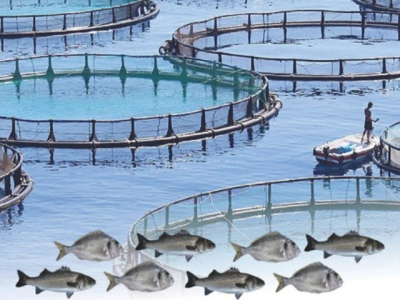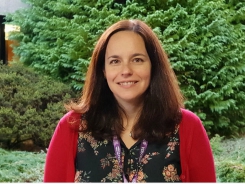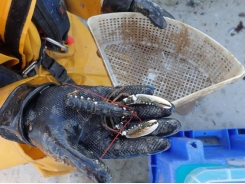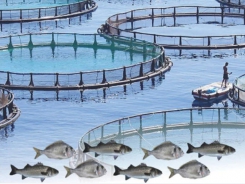A Guide to Acceptable Procedures Practices for Aquaculture Fisheries Research - Part 2

1. Animal husbandry (next)
1.1. Basic husbandry
1.1.3. Water quality variables
Alkalinity
Alkalinity is the total quantity of ‘bases’ present in water (primarily carbonate and bicarbonate ions) and is measured as mg/L of equivalent calcium carbonate (CaCO3). The bases ‘buffer’ water against changes in pH. Waters of low alkalinity (eg < 20 mg/L) are poorly buffered and are relatively unproductive for fish culture. A desirable range of alkalinity is 50-200 mg/L, but fish survive in waters up to 400 mg/L.
Hardness
Is the total concentration of metal ions (mainly calcium and magnesium) in water and as it is also expressed as mg/L CaCO3. Waters of low hardness (eg. < 20 mg/L) are called ‘soft’ while those above 200 mg/L are ‘hard’. Most productive waters are between about 20 and 250 mg/L CaCO3. In general, where the alkalinity is derived from calcium or magnesium carbonate, hardness and alkalinity values are similar. However, if alkalinity is derived from sodium bicarbonate (NaHCO3), it is possible to have soft water with a high alkalinity. Waters with hardness values over 400 mg/L or less than 20 mg/L are unsuitable for most fish.
Ammonia and Nitrite
Ammonia is the major product excreted when fish (and other aquatic animals) catabolise protein. It is excreted across the gills and in urine and faeces. Ammonia is also a by-product of the decomposition of organic matter by bacteria. In water, total ammonia exists in two forms; a 11 NSW Department of Primary Industries (Fisheries) ACEC, October 2015A Guide to Acceptable Procedures and Practices for Aquaculture and Fisheries Research 12 NSW Department of Primary Industries (Fisheries) ACEC, October 2015 highly toxic unionised form (NH3) and a much less toxic ionised form (NH4+). The proportion of ammonia in each form depends on pH, temperature and salinity. For example, at a pH of 8.0, 1.6% of ammonia is in the toxic unionised form at 8o C, but 8.8% at 32o C. Similarly, at 24o C, 0.5% of ammonia is in the unionised form at a pH of 7.0 compared with 34.4% at a pH of 9.0. Fortunately, ammonia is very soluble and is readily used as a nutrient by plants. So, when pH rises in ponds with algal blooms, ammonia concentrations tend to be low.
Ammonia is ‘nitrified’ to nitrite and then to nitrate through a two-step process by the ‘nitrifying’ bacteria Nitrosomonas and Nitrobacter. These bacteria occur naturally and are the main agents responsible for removing ammonia and nitrite in biological filters. At high levels, nitrite replaces oxygen in the blood to form methaemoglobin. Gill filaments become brown giving rise to the condition ‘brown blood disease’. Nitrite toxicity is reduced when chloride is present in the water.
Adding salt at 5 g/L is very effective in reducing toxicity and explains why marine and estuarine fish are much less susceptible than freshwater species.
Sensitivity of fish to ammonia and nitrite varies between species and age/size of fish. Lethal levels (acutely toxic concentrates that are predicted to kill 50% of the population over 4 days) are around 1.0 mg/L unionised ammonia and 160 mg/L nitrite. However, growth of silver perch is reduced when concentrations are above 0.36 mg/L unionised ammonia or 1.4 mg/L nitrite over three weeks.
Nitrogen is not normally toxic to fish, but if the water is supersaturated, the nitrogen can cause gas bubble disease which can kill fish. Bubbles form under the skin, behind the eyes or in blood vessels, in the same way ‘the bends’ occur in humans. Supersaturation can occur when water is pumped under pressure or derived from under-ground. Such water should be passed through ‘degassing’ columns and/or vigorously aerated before use.
Hydrogen sulphide
This compound is produced by the bacterial decomposition of organic matter under anaerobic (without oxygen) conditions. Hydrogen sulphide smells like rotten-eggs and is often called ‘rotten-egg gas’. Concentrations less than 1 mg/L can be lethal to fish. It can be removed from the water by vigorous aeration or by adding potassium permanganate.
Turbidity
This refers to the amount of suspended material such as clay, organic material or plankton (including plants, phytoplankton or zooplankton) in water. Turbidity is not usually harmful to fish.
Turbid water can help prevent colonisation of the pond bottom by aquatic plants that can interfere with harvest operations. Excessive and/or persistent clay turbidity can interfere with development of beneficial algal blooms in ponds, while excessive organic turbidity can increase biological oxygen demand and lead to problems with low levels of dissolved oxygen.
1.1.4. Water quality management
Maintenance of good water quality is one of the most important aspects of fish husbandry, and the majority of problems occurring in a hatchery/aquarium are associated with poor water quality. Water quality in freshwater aquaculture is discussed in detail by Rowland (1998).
Maintenance of good water quality requires the regular monitoring of dissolved oxygen, temperature, pH and ammonia, and for marine and brackish water species, salinity. Because dissolved oxygen is a key limiting factor, all culture units are aerated; tanks continuously and ponds nightly (for details see Rowland 1998; Rowland et al. 2007)A Guide to Acceptable Procedures and Practices for Aquaculture and Fisheries Research 13 NSW Department of Primary Industries (Fisheries) ACEC, October 2015
Water exchange
The three basic systems of water exchange/circulation are a) static, b) flow-through and c) recirculating systems.
A.Static systems
Static systems do not receive continuous water inflow. They rely on relatively low stocking densities and biomass, and/or in the case of ponds, natural processes within the system to maintain water quality. Most earthen ponds are run as aerated, static systems, with periodic additions of water to replace that lost through evaporation and seepage. Water exchange can be achieved by over-flow or by partially draining the pond or tank and then replacing lost water. Water exchange can be used to improve water quality when a ‘crisis’ occurs (eg. algal bloom crashes followed by low dissolved oxygen).
B.Flow-through systems
In flow-through systems there is a ‘single-pass’ of water, ie. water is only used once, and the tank, raceway or pond usually remains full with water entering and leaving the system at the same time from different locations. For tanks and ponds, water inflow should be designed to maximise mixing and help concentrate solids near the drain or outflow (eg. used to generate a circular water current). Out-flowing water leaves via an overflow (eg. monk, external standpipe) and in tanks is drawn from the bottom; such tanks are ‘self-cleaning’.
C.Recirculating aquaculture systems
Tank-based recirculating systems (RAS) can be use for a range of purposes including quarantine, broodfish and over-wintering fingerlings at elevated temperatures. Some species such as Murray cod and barramundi can be grown to market-size (> 500 g). RAS are characterised by: re-conditioning and re-use of water; mechanical filtration to remove solids; biological filtration to convert ammonia to nitrite and nitrate; high stocking densities and production rates; low water and land requirements; and potential for good control of water quality, wastes, temperature and culture conditions. Depending upon the complexity of the system, RAS can also include foam fractionation (air or another gas is bubbled through a column of water to trap and remove organic particles) and methods to increase dissolved oxygen (eg. pure oxygen injection). Treatments to remove or reduce potential pathogens, such as ozonation or UV filtration are sometimes included in RAS.
NOTE: Biofilters must also be managed as a living, breathing organism. Most importantly, it takes time for surface bacteria or biofilters to establish. The time depends upon the amount of nutrients supplied, temperature of the water and water-flow characteristics of the system. Bacterial preparations and food (nutrients) are available and can be used to reduce this ‘start-up’ time that typically is between 1-3 months. Care must be taken to ensure the filter is not starved of nutrients or that chemicals used to treat fish (eg. formalin) do not affect the biofilter. Careful monitoring should be undertaken when changes in the filter-loading rates (ie. when fish are added or removed) are made or when any chemicals are used.
Turbulence
Turbulence in tanks is caused by aeration or water inflow and keeps solids suspended in the water column. Turbulence also mixes water, but needs to be kept as low as possible when rearing larvae up to 10 days old. Larvae must not be prevented from reaching the surface during this period to enable swim-bladder inflation. After this period, increased turbulence assists in food distribution, enabling uniform growth and potentially reducing the incidence of cannibalism. A Guide to Acceptable Procedures and Practices for Aquaculture and Fisheries Research 14 NSW Department of Primary Industries (Fisheries) ACEC, October 2015
Skimmers
If rearing larvae, surface skimmers should be in place during swim-bladder inflation to reduce oil scum, which may prevent larvae from gulping air on the water surface. Skimmers are not necessary after this stage, but certainly aid in the removal of excess lipids and proteins from the tank.
Cleaning
Self-cleaning tanks reduce the need for cleaning. Static tanks should be cleaned regularly, by siphon or vacuum pump, to reduce problems with the accumulation of organic matter (uneaten food, faeces) and fouling organisms, bacteria and algae. Tanks not in use should be left dry. Sand filters need to be backwashed regularly, and cartridge filters should be cleaned and dried periodically to prevent build up and decomposition of accumulating waste material and to ensure efficient operation. Floors, drains, etc., associated with tank rooms should be cleaned and sterilized on a regular basis. Dilute pool chlorine or sodium hypochlorite (NaOCl 20 ppm) or caustic soda (NaOH 1%) are suitable cleaning agents for this purpose.
Related news
Tools

Phối trộn thức ăn chăn nuôi

Pha dung dịch thủy canh

Định mức cho tôm ăn

Phối trộn phân bón NPK

Xác định tỷ lệ tôm sống

Chuyển đổi đơn vị phân bón

Xác định công suất sục khí

Chuyển đổi đơn vị tôm

Tính diện tích nhà kính

Tính thể tích ao




 A Guide to Acceptable Procedures Practices for Aquaculture…
A Guide to Acceptable Procedures Practices for Aquaculture…  A Guide to Acceptable Procedures Practices for Aquaculture…
A Guide to Acceptable Procedures Practices for Aquaculture…